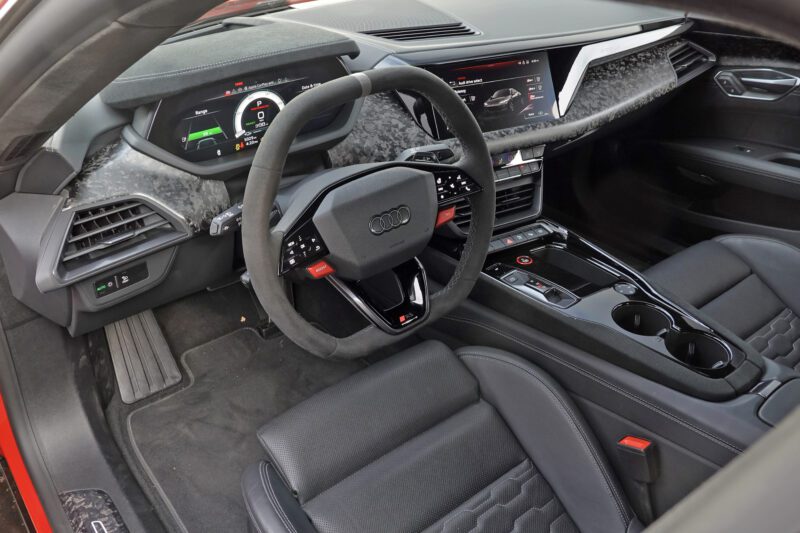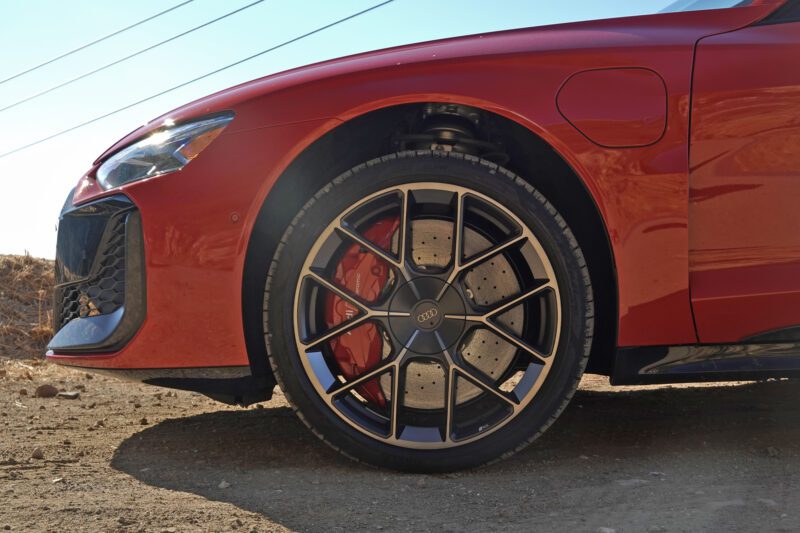New 912-HP Electric Sedan Truly Takes on the Porsche Taycan
Hammering launch control in Audi’s new RS e-tron GT Performance chirps the tires for a microsecond, before unleashing an unbelievable onslaught of acceleration that builds and builds into triple-digit speeds with ease. Ripping through mountain roads, the four-door sedan can also corner with the best sports cars on the planet thanks to an impeccable new adaptive suspension system and quintessential Quattro all-wheel drive. The only clue to the mass of the Performance’s electric powertrain emerges whenever I slammed hard on the brakes, which overwhelms the tires due to battery weight and quickly brought on the shudder of ABS pulses.
The new Performance trim of the RS e-tron GT deserved a few rounds of hard canyon carving over my week-long loan, if only to explore the massive step up in power from 637 hp previously (with overboost) to a new peak of 912 hp from dual electric motors. In fact, it’s the most powerful Audi ever – and by a long shot. Increased battery capacity, now up to 105 kilowatt-hours, still allows for a range of 278 miles despite the power gains. And yet, as with so many EVs, maintaining that range forced the Performance to tip the scales well above 5,000 pounds.

Perhaps the most impressive part about the Performance is how well Audi camouflages that weight using a new dual-chamber and dual-valve adaptive air suspension system to impart a strong sense of agility. Of course, 912 horsepower helps by delivering the kind of brutal gut punch – really, at any speed – formerly reserved for seven-figure supercars. Activating launch control off the line requires selecting RS Performance mode, then turning traction control fully off. Push the brake pedal all the way to the floor, then the accelerator, and for a few seconds the whole car then seems to hunker down like a cheetah waiting to pounce before unleashing so much power. Audi claims a 0-60 time of just 2.4 seconds, but by the seat of my pants, the Performance felt even quicker.
A serious set of massive carbon-ceramic brakes (optional as part of the Dynamic Plus Package for $11,000) easily hauls down that speed, with barely perceptible modulation between 400 kilowatts of regen and more traditional friction braking. In fact, even with the tires fully warmed up on a hot day, I found the 420-mm and 410-mm front and rear rotors can easily overwhelm traction of the EV-specific Pirelli P-Zero NFO Elect tires. A car with this much power, with such great handling despite so much weight, truly deserves more performance-oriented tires—Michelin Pilot Sports sure seem worthy.
Audi ensured the Performance trim prioritizes handling just as much as straightline starting and stopping, and the steering seems borrowed directly from the RS e-tron GT’s Porsche Taycan sibling. So dialed in and precise, with just enough resistance to cornering from the thin-rimmed “squircle” steering wheel, which firms up predictably in more aggressive modes. I strongly suspect that lessons learned on this car may well have trickled down to lower-spec models, including the recently unveiled A5 and Q5 that improved significantly on previous Audis’ typically lightweight and numb steering.
There’s no “Catch-22” here, either: The sheer pace and handling prowess never impinge on a smooth and luxurious ride. As with other Audis, and especially the electrics, this incredibly powerful sedan glides over rough roads and absorbs more bumps with aplomb, as wind or tire noise, and zero creaks or rattles intrude on the serene cockpit. The new suspension makes a huge difference, broadening the capability for the Performance to float along in Comfort mode or tighten up body roll with any of the three RS modes selected.

Even rolling the windows down makes minimal noise, and amid the silent reverie, turning up the Bowers & Wilkins sound system reveals such crisp highs and deep bass that even familiar songs on my usual playlists began to sound brand-new again. I always turned down the fake powertrain sounds, though, and activated those powerful seat massagers to enter full EV bliss mode.
Speaking of convenience, that suspension also enables “Elevated entry” mode, which puffs up the car by a few inches to make getting in and out a little easier for taller drivers. But that does bring up the e-tron GT’s biggest issue, a notable lack of space throughout the compact interior despite the car’s large exterior footprint. At six-foot-one I fit just fine int he front seat. But where other automakers optimize skateboard battery layouts to create more luxurious cabin configurations, the Porsche-Audi siblings do not – only a large trunk for weekend luggage or golf clubs seems fitting, but don’t expect much in the way of rear seat head or legroom here.

Similarly, it’s odd that Elevated entry can almost immediately raise the entire car by up to a max of 42 millimeters (1.65 inches) but Audi still decided against a front-axle lift option. The nose of the RS e-tron GT Performance will therefore scrape on moderate driveways and drainage dips, even in the most lifted suspension setting. Luckily, the copious use of carbon-fiber trim doesn’t extend to a front splitter which might get damaged due to the lack of front-axle lift.
The range of 278 miles seemed legit, too, and plenty sufficient for daily life, if not quite ideal for long road trips. I never needed to charge over a full week of daily driving and canyon carving, though of course, the inevitable urge to enjoy all those 912 horsepower with repeated romps on the throttle pedal does eat into battery charge quite rapidly. I also never noticed any power de-rating or overheating while ripping through Malibu canyons on days that climbed up to the high-80s, weather conditions which typically frustrate other high-performance electrics. Plus, the peak charge rate for the Performance increases to 320 kilowatts, which Audi claims will allow for a 10-80% fast charge in just 18 minutes.

I do prefer the Audi design versus the smoother and less futuristic Porsche Taycan, for all but the rear end (other than the Taycan Cross Turismo wagon, anyway). And the interior is more quintessential Audi, with sculptural design elements throughout from the door pulls to the dash trim. A carbon-fiber roof rather than panoramic glass helps to keep the interior cooler—pun intended—but some of the forged carbon-fiber trim might go a little overboard, dropping the restrained German aesthetic in favor of more flashy bits on the mirrors, side sills, front and rear aero inlets, and especially the wide dash.
The Forged Carbon Package on this press loaner contributed $8,400 to a $190,690 MSRP, up from $167,000 to start. It also includes the 21-inch wheels in addition to the miracle material, but probably matters less than the Dynamic Plus Package that adds the active suspension and carbon-ceramic brakes. To my eye, the piano-black plastic of the center console also should be in carbon or at least brushed metal, since it gets dirty quickly and stands out as looking much cheaper than the rest of the cockpit. And I’d spec my RS e-tron GT Performance in any color other than this Progressive Red Metallic paintjob, for a restrained daily driver that can easily double as an absolute screamer when the time comes. A silent screamer, that is.
Images: Michael Van Runkle
